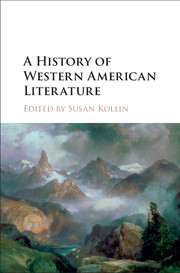Book contents
- Frontmatter
- Contents
- Notes on Contributors
- Acknowledgments
- Introduction: Historicizing the American Literary West
- PART I HOMELANDS
- PART II MAKING A REGION
- PART III GEOGRAPHIES OF THE LITERARY WEST
- PART IV THE TWENTIETH CENTURY AND BEYOND: LITERARY MOVEMENTS AND CRITICAL PERSPECTIVES
- 14 Early Cinematic Westerns
- 15 The Environmental Novel of the American West
- 16 Hard-Boiled Fiction and Noir Narratives
- 17 The Beats and the American West
- 18 Contested Wests: Indigenous Americans and the Literature of Sovereignty
- 19 Asian American Writers and the Making of the Western U.S. Landscape
- 20 African American Literature: Recasting Region through Race
- 21 Hollywood Westerns: 1930s to the Present
- 22 Urban New Wests
- 23 Queer Frontiers: Gender and Sexuality in the American West
- 24 Postwestern Literature and Criticism
- Selected Bibliography
- Index
15 - The Environmental Novel of the American West
from PART IV - THE TWENTIETH CENTURY AND BEYOND: LITERARY MOVEMENTS AND CRITICAL PERSPECTIVES
Published online by Cambridge University Press: 05 November 2015
- Frontmatter
- Contents
- Notes on Contributors
- Acknowledgments
- Introduction: Historicizing the American Literary West
- PART I HOMELANDS
- PART II MAKING A REGION
- PART III GEOGRAPHIES OF THE LITERARY WEST
- PART IV THE TWENTIETH CENTURY AND BEYOND: LITERARY MOVEMENTS AND CRITICAL PERSPECTIVES
- 14 Early Cinematic Westerns
- 15 The Environmental Novel of the American West
- 16 Hard-Boiled Fiction and Noir Narratives
- 17 The Beats and the American West
- 18 Contested Wests: Indigenous Americans and the Literature of Sovereignty
- 19 Asian American Writers and the Making of the Western U.S. Landscape
- 20 African American Literature: Recasting Region through Race
- 21 Hollywood Westerns: 1930s to the Present
- 22 Urban New Wests
- 23 Queer Frontiers: Gender and Sexuality in the American West
- 24 Postwestern Literature and Criticism
- Selected Bibliography
- Index
Summary
First a bald-faced proposition, and then a few broad observations, all of which will be refined in the sequel: Any novel of the American West is likely to be “environmental” to some degree. This likelihood is entailed by the geographical designation that serves to distinguish such a novel from other works of fiction. Otherwise the question of its character, as distinct from the general run of novels, might be moot. So one can argue that the novel of the American West tends to be “environmental” as a matter of literary and cultural necessity.
This necessity is illustrated by the history of the western as a perennially popular genre, one in which particular environments are referenced in titles and serve as settings for novelistic action, if only in a token and conventional fashion much of the time. Think of titles such as Riders of the Purple Sage, The Sea of Grass, The Big Sky, and To the Far Blue Mountains. As if they were setting a stage, writers of genre westerns scatter sagebrush and prickly pear in the foreground like potted plants, prop cutouts of cattle and horses in the middle ground, hang turkey vultures and red-tailed hawks in the sky like paper moons, and pose characters before a lifelike scrim of distant, snowcapped mountains. This stage setting may be simplistic, but it is also surprisingly effective: Readers of westerns often develop a love of desert, prairie, and mountain landscapes without venturing into them other than on the page and come to regard such landscapes as quintessentially American – and as iconographic.
Nevertheless, that environment can be evoked in this perfunctory way, as splashes of local color, as mere backdrop, or as a matter of sheer coincidence, as the spot on the map where, thanks to the contrivances of plot, characters just happen to meet and interact; and that environment thus can be evoked without its becoming a shaping influence on a novel's composition and point of view, and without its posing a challenge to a reader's cozy assumptions about the course of U.S. national and environmental history; all this means that drawing a few distinctions is in order.
- Type
- Chapter
- Information
- A History of Western American Literature , pp. 242 - 255Publisher: Cambridge University PressPrint publication year: 2015

